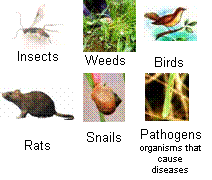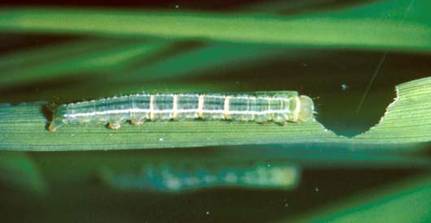|
|
|
Pest management |
|
|
|
|
|
|
|
|
|
Introduction to Integrated Pest Management (IPM) |
|
|
|
|
|
|
|
|
|
Describe the characteristics of IPM |
|
|
|
|
What is a pest? In agronomy, a pest is any organism or microbe with the potential to lower the value of a crop by reducing:
Types of pests in the rice paddy
|
|
|
|
|
Rice intensification has caused an increase in pests
In the 1960s, rice research played a major role in addressing the challenge of increasing food production. With improved rice cultivars, the yield potential was increased, the growth duration shortened, and the responses to irrigation and added nutrients increased. Two and sometimes three crops of rice were grown on the same piece of land.
The result was called the “green revolution”, which produced an unprecedented leap in rice production-enough to feed at least 600 million more people at affordable prices.
Like every breakthrough in development, this achievement had another side: unforeseen social and environmental costs. Efforts to modernize and intensify rice production also worsened pest problems, especially in irrigated rice. Insect and disease buildup in the 1970s reduced the usefulness of the first IRRI cultivars IR8 and IR5.
Intensive chemical treatments were used to counter these pests while resistant cultivars were being developed. Farmers became accustomed to applying insecticides at fixed intervals and often with government-subsidized prices. These treatments seemed to provide insurance for farmer investments in irrigation, fertilizer, and other inputs. Because the first high-yielding modern rice cultivars were susceptible to pests, insecticide use spiraled. This trend continued even after the introduction of resistant varieties. Worldwide, more pesticides are used for rice than for any other single food crop.
|
|
|
|
|
What is the problem of pesticides?
Misuse and unnecessary use of pesticide can negatively impact the natural impact the natural balance in ecological communities of rice fields. Human health is also affected.
|
|
|
|
|
What is the concept of IPM?
The basic premise of IPM is that no single pest control method can be successful over a long period of time. A mixture of biological, physical, and chemical methods must be integrated into a strategy designed to provide durable and sustainable systems of pest management.
IPM combines resistant cultivars, agronomic practices known to reduce losses of pests, and conservation practices that preserve and increase natural enemies. Pesticides are applied only when necessary and economically efficient; and then, only pesticides that have a low risk to human health and to the environment are used. Decisions on whether to apply pesticides are based on criteria that identify when and where chemical control is truly justified. For long-term pest management success, strategies to control multiple pests must be integrated into crop production systems.
Researching, developing, and implementing effective, sustainable IPM strategies require the cooperation of specialists from several disciplines and the active participation of extension services, non-government organizations, and farmers. With appropriate institutional support, farmers can be equipped with IPM concepts. Combined with their indigenous knowledge, they will be able to develop their own best mix of pest control techniques.
The research community and the chemical industry are being challenged to develop new strategies that will eliminate the use of pesticides that are potentially hazardous to human health. This is particularly important in countries where the safe use of pesticides cannot be guaranteed.
|
|
|
|
|
The goal of Integrated Pest Management is the application of economically efficient and environmentally sound pest management tools and techniques.
|
|
|
|
|
|
|
More information about IPM
|
|
For more information, visit the Rice Knowledge Bank at: http://www.knowledgebank.irri.org/RiceIPM/default.htm |
|
Next lesson |
|
In the next lesson we will discuss the pest of insects. |
|





